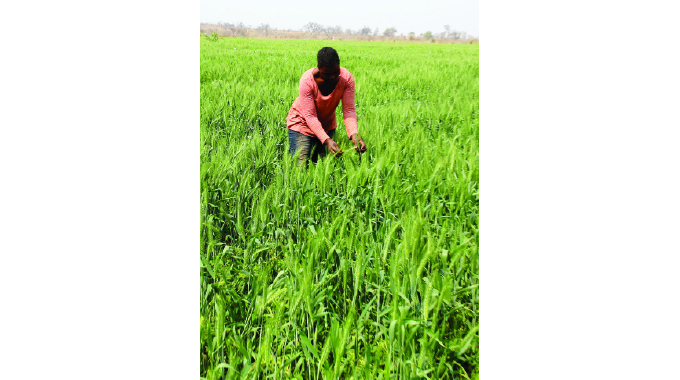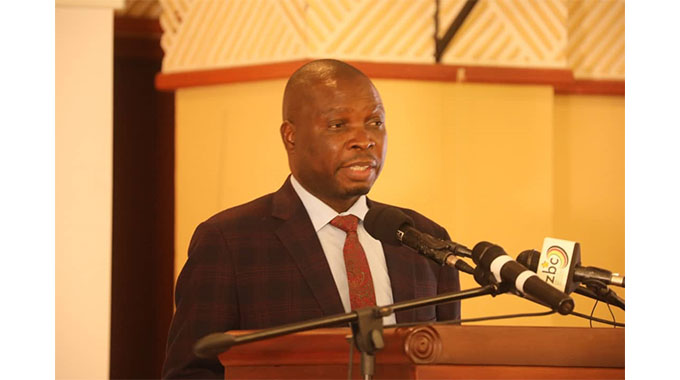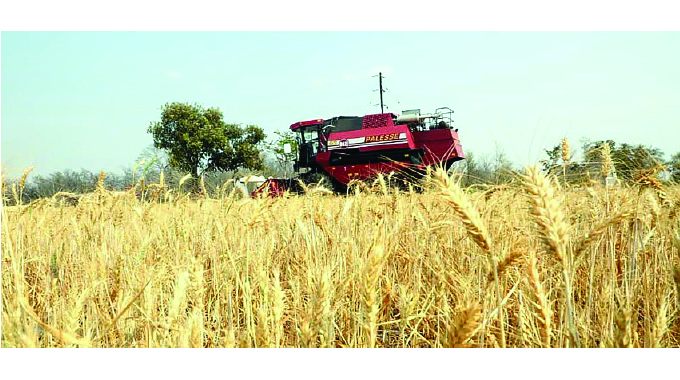The Chronicle

Nqobile Tshili, Chronicle Reporter
FARMERS in Matabeleland North have increased their wheat hectarage from last year’s 950 hectares to about 3 000 hectares as the province moves towards enhancing the country’s food security and attainment of a US$8,2 billion agriculture economy in line with Vision 2030.
Food insecurity is a global threat affecting almost every nation with Zimbabwe not spared. The global food crisis has been triggered mainly by prolonged droughts due to climate change, the Covid-19 pandemic and the on-going Russia-Ukraine conflict, which has affected the global food supply chain.
Ukraine contributed 30 percent worldwide supply of the wheat. Following the Russian-Ukrainian conflict, the Government took a bold step to increase wheat farming and expects to produce a record high harvest of 380 000 tonnes this year since the 1960s when Zimbabwe planted its first wheat crop.
The country requires about 360 000 tonnes of wheat annually and will have a surplus of the crop, thanks to a well-coordinated programme by Government and private sector players.
While in some parts of the country, harvesting of the crop has started, farmers in Matabeleland North expect to commence the exercise next week with more farmers expected to join in next month.
The province has new wheat farmers who also want to be part of the initiative to transforming the country’s agriculture sector to ensure food self- sufficiency for the country.
It’s not only farmers with vast tracts of lands who planted the winter wheat crop, but small-scale farmers are also involved.
One of the new wheat farmers, Mr Collin Mujuru of Nyamandlovu in Umguza District planted 2,5 hectares and is optimistic of recording a bumper harvest.
 Petronella Zulu in their wheat crop field yet to mature in Umguza
Petronella Zulu in their wheat crop field yet to mature in Umguza“I was encouraged by other farmers in the district to also venture into wheat farming since it is a cash crop. I am also one of the farmers who benefited from the Presidential Inputs Scheme although I complemented by buying some of the required chemicals,” he said.
Mr Mujuru hopes to harvest the crop in November.
Acting provincial director for Agricultural Rural Development and Advisory Services in Bulawayo and Matabeleland North, Mr Dumisani Nyoni said wheat production in the province was impressive.
“We have 2 860 hectares that we planted this year compared to 950 hectares that we had planted last year. We partly attribute the increase in wheat production to Arda Jotsholo which significantly increased its wheat crop production due to improved access to water,” he said.
“In addition to that, the line of funding also increased. We had four different options for funding, which included the Presidential Inputs Scheme, CBZ, self-funding and farmers who were contracted by Food Crop Contractors Associations where the private sector contributed to improved crop production.”
Mr Nyoni said for the first-time wheat farmers to realise their full potential, they require a lot of technical and financial assistance.
“These farmers encounter a lot of challenges, and for instance, if the pump they will be using breaks down, it takes longer for them to fix the pump resulting the crop being affected,” he said.
“More credit lines for these small-scale farmers should be availed so that they can easily access funding in the event of encountering such challenges during the cropping period.”
Mr Nyoni said farmers in the Matabeleland region have a potential to contribute more to the national basket.
He said the 10 000 hectares that have been identified for irrigation purposes upon completion of Lake Gwayi will be a game changer for the region.
“We expect that the region will become food sufficient especially with those 10 000 hectares that have been identified for irrigation farming along the Lake Gwayi-Shangani pipeline. We want the region to be counted when it comes to food self-sufficiency in Zimbabwe,” said Mr Nyoni
Matabeleland North Provincial Affairs and Devolution Minister Richard Moyo, who is also a farmer with a thriving wheat crop said, it is encouraging that the region is contributing towards enhancing food security in the country.
 Matabeleland North Provincial Affairs and Devolution Minister Richard Moyo
Matabeleland North Provincial Affairs and Devolution Minister Richard MoyoThe minister planted 24 hectares of wheat, which he expects to harvest next month.
“We are walking the talk in terms of implementing Government projects. This is why I’m also involved in wheat farming, following in the footsteps of President Mnangagwa who is also a farmer at his Sherwood Farm in Kwekwe,” said Minister Moyo.
“By embracing Government projects, it becomes even easier for me to tell farmers of the need to contribute to the national basket.”
Minister Moyo urged farmers to be productive on their pieces of land so that there is import substitution.
“When as a country, we stop importing food, the foreign currency will then be channelled towards the productive sectors and improve the performance of our economic growth,” he said.
Launching the National Development Strategy 1 (NDS1) in November 2020, President Mnangagwa said under the five-year Government economic blue-print, all sectors of the economy are obliged to increase their productivity.
 Wheat harvesting in progress
Wheat harvesting in progressUnder the NDS1, more resources and greater momentum are being injected towards dam construction and efficient irrigation systems.
The Second Republic has made food security a top priority and is working towards a US$8,2 billion agriculture industry economy, contributing 20 percent of GDP by 2025, underpinned by the country’s NDS1 — the driver towards Vision 2030 to make Zimbabwe an upper middle-class economy.
Efforts being made by the Second Republic will cumulatively see the country achieve the US$8,2 billion agriculture sector economy.
In 2019, the Government introduced the Climate-Proofed Presidential Inputs Scheme, popularly known as Intwasa/Pfumvudza.
The Pfumvudza farming concept is a sustainable way of crop production intensification whereby farmers use few resources, expend energy on a smaller piece of land, thereby reducing labour.
Thus, farming through the Pfumvudza concept allows the country to gain economic stability, decrease food insecurity and empower farmers to not only feed the nation but other regional countries.
Intwasa/Pfumvudza was recently recognised by the Food and Agriculture Organisation (FAO). It was awarded a local research and farming institution, Foundation for Farming (FfF), with a Partnership Award.
FAO said FfF’s Intwasa/Pfumvudza farming initiative helped about nine million Zimbabweans to achieve household food security. – @nqotshili.
Article Source: The Chronicle
